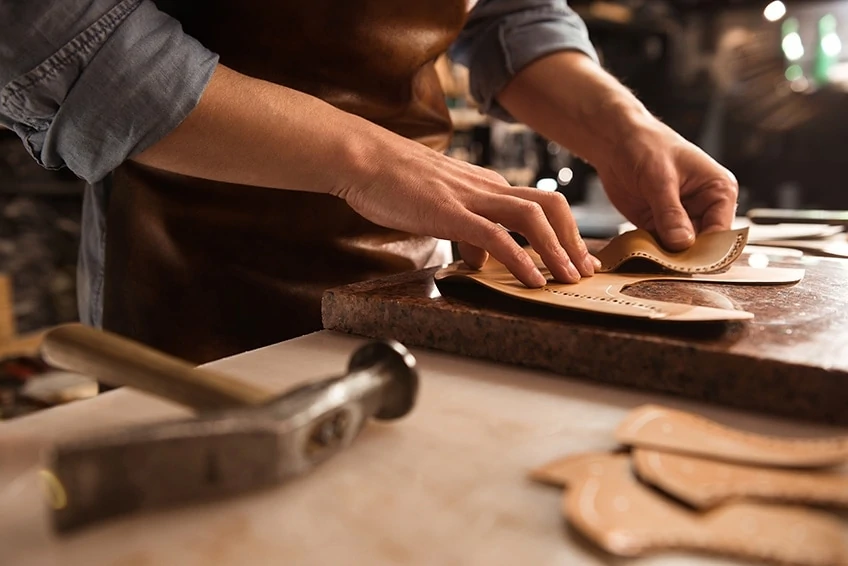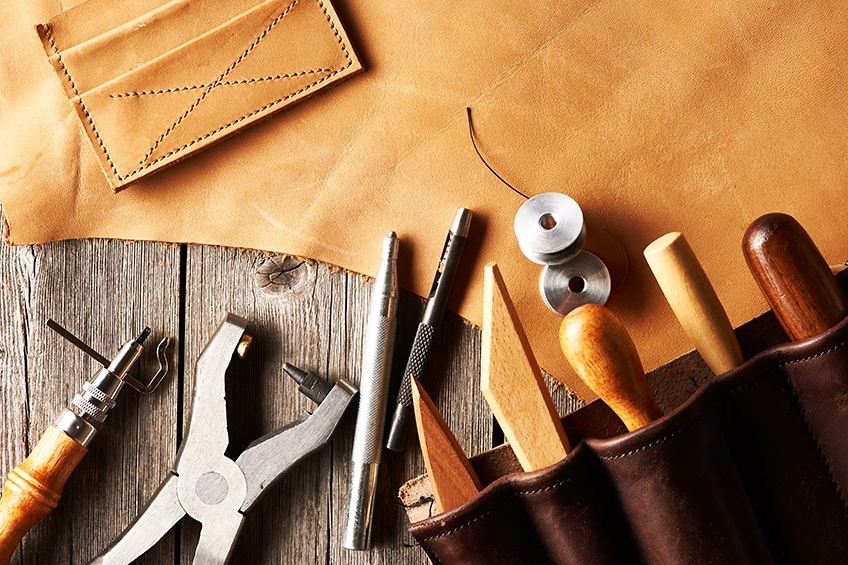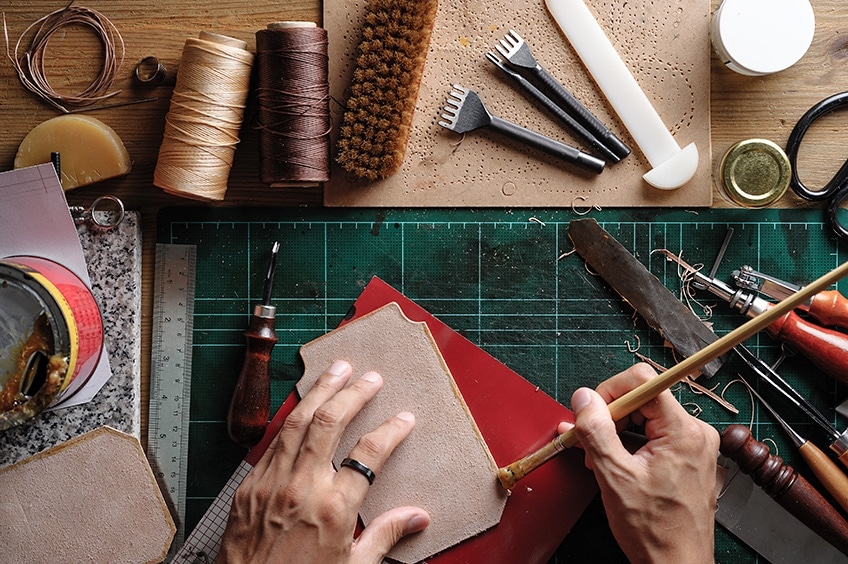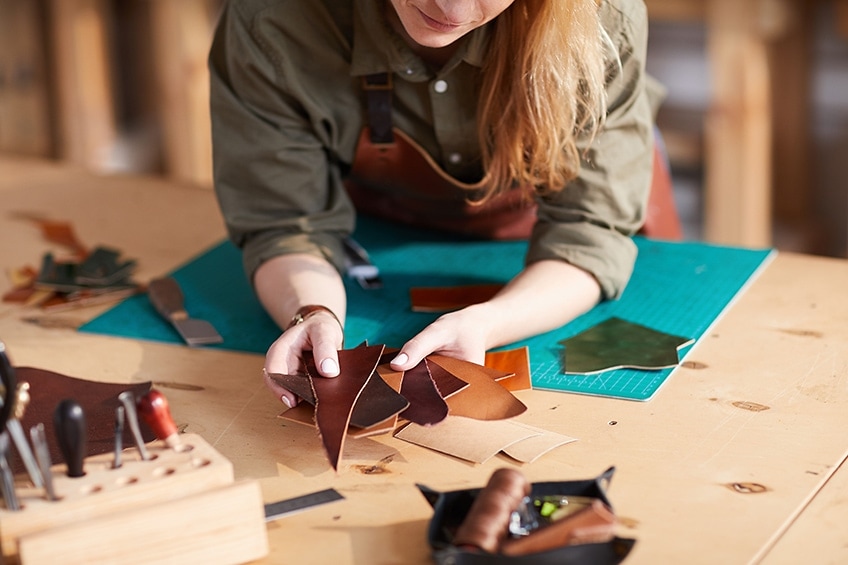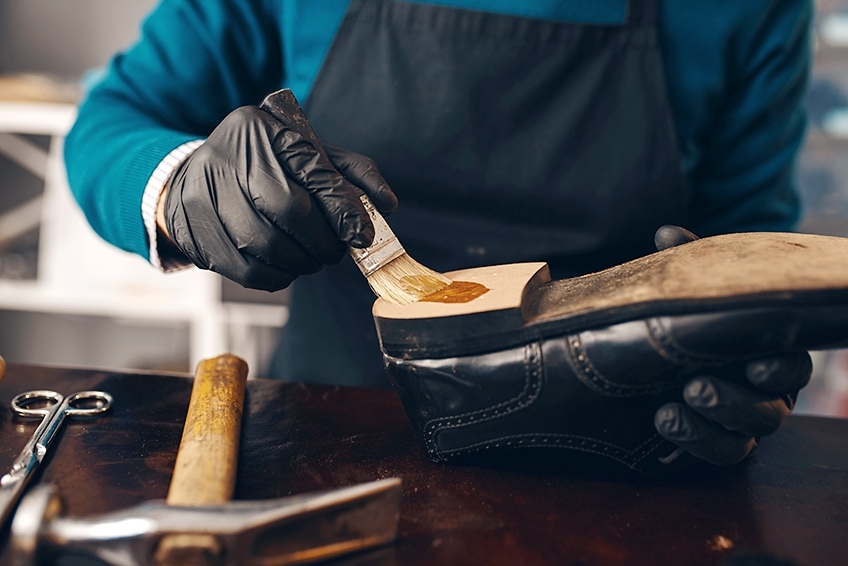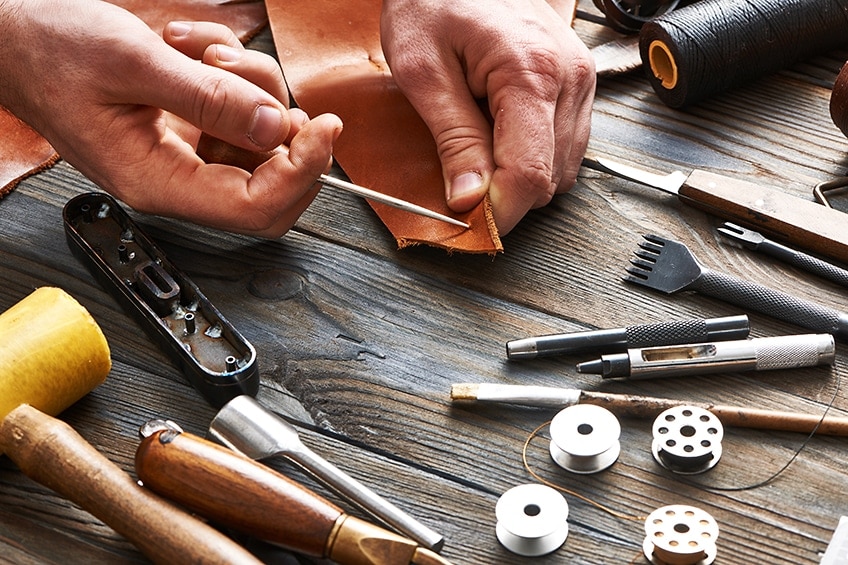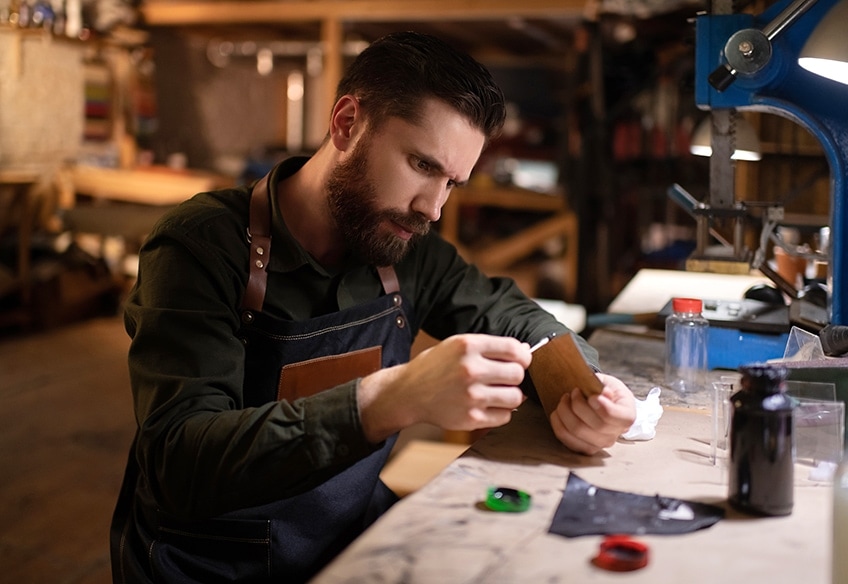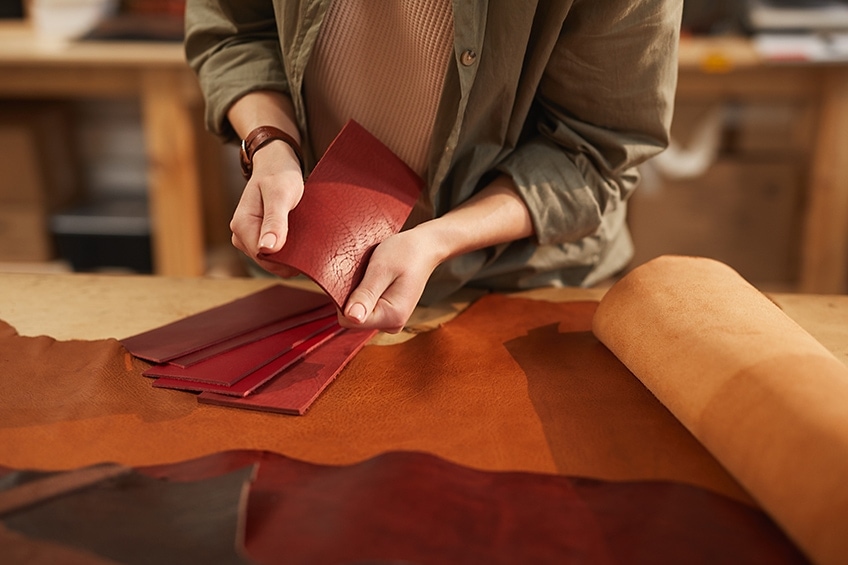Best Glue for Leather – Guide for Leather Adhesives
This post may contain affiliate links. We may earn a small commission from purchases made through them, at no additional cost to you. You help to support resin-expert.com
Leather is a noble and visually appealing material, whether real or faux. However, as it is flexible, repairing or gluing this material can hold some surprises in store. Not every leather glue is suitable, even if its packaging promises this. This adhesive guide will explain how you can recognize the right adhesive for both leather and faux or imitation leather, and how you can glue leather optimally.
Table of Contents
Properties of Leather
Leather is an animal material – more precisely, animal hide – which has been made durable by a special process called tanning and the use of chemicals. The animal hide usually comes from either pigs or cattle, and sometimes even from horses. Further processing and conservation results in a supple and versatile, but relatively sensitive, material. Leather is characterized by several highly positive properties:
- Leather is very durable and long-lasting if it is cared for properly.
- It is almost completely impermeable to water, but still has high breathability.
- It can be used for many different applications, such as for car seats, belts, shoes, seating furniture, or handbags.
- It offers a very attractive appearance.
The smooth exterior of the leather is created by the papillary layer, while the underlying reticular layer is responsible for the coarser fibers.
Apart from sewing, the bonding of leather has a wide range of applications; however, a few things should be considered. Not every leather glue keeps its promises. Some types of glue disfigure the leather by staining it, which can easily happen even a year after the gluing process. And gluing leather to leather requires a completely different type of glue than gluing leather to a hard material. Which leather glue you use therefore depends on many different factors.
Methods for Bonding Leather
Leather can be joined in various ways. One of the most popular techniques, however, is leather gluing. This is mainly used in the shoe industry and in the furniture industry. The gluing of leather offers you many possibilities to repair furniture or to design and decorate objects and clothes. You can decorate bags, shoes, or hats with leather applications.
It is even possible to glue leather to plastic, such as if you were to cover the center console of your car with leather. However, you must make sure that the leather adhesive is heat-resistant, because in summer, various interior parts of the car can easily be exposed to temperatures of 140 degrees Fahrenheit (60 degrees Celsius) or more.
It is also possible to repair leather car seats or leather-covered steering wheels. Car upholsterers work comparatively often with heat-activated adhesives.
Properties of a Good Leather Adhesive
Leather can be bonded with many different adhesives. However, when bonding leather you should pay attention to the second substrate, i.e. the joining partner. If this is a flexible material, you should aim for an elastic leather adhesive. For example, if you want to glue leather to a fabric or cover a sofa with leather, you should never use superglue, because it is not elastic. However, if you want to glue leather to wood, you can use a superglue, as the latter is a hard material.
It is important to pay attention to the tanning agents used to make the leather durable, as these can react with the glue in different ways and affect the adhesive properties. The color can also suffer from an unsuitable leather adhesive, where unsightly discoloration can occur.
For these reasons, you should always test a leather adhesive first. We suggest bonding a small sample of the leather to the second substrate and waiting for the adhesive to cure completely before you start bonding. Apart from these things, a solid adhesive for leather should generally meet the following requirements:
- Even if you glue leather to a hard material, the glue should still be reasonably flexible to adapt to the elasticity of the leather.
- The appearance of the leather must not be impaired, i.e. the leather adhesive must not penetrate the surface. Caution is required at this point! Because some adhesives only react with the substrates after more than a year, and ugly stains can form after that time.
In general, the user can choose between special leather adhesives, contact adhesives, spray adhesives, and superglues.
Another adhesive of choice for leather bonding would be a solvent-free dispersion adhesive with properties similar to those of solvent-based adhesives. Such leather adhesives are available on a polychloroprene or polyurethane basis, for example.
Nowadays, there is also double-sided adhesive tape for leather bonding on the market. However, it is not suitable for every application. They are mainly used for laminating large leather pieces onto hard surfaces. The best types of leather adhesive are discussed in more detail in the following chapter. We will introduce you to the three most suitable types.
The Best Leather Adhesives
There are so many adhesives for leather advertised on the market that it can be difficult to select the most suitable product for your particular piece of leather. We have done the work for you and found three of the best leather adhesives for you to choose from.
Recommendation for Leather Gluing: Special Leather Glue
Special leather adhesives were developed especially for leather bonding and not only develop optimal adhesive properties, but also do not penetrate the surface. One of the best glues for leather is Fiebing’s Leathercraft Cement. This product is easy to use on leather as well as other materials, and offers a quick-drying yet high-strength bond for your leather items. This adhesive is safe and non-toxic, and is also non-flammable. Enjoy a durable and long-lasting bond with a clear finish when you use this glue.
- Easy to use, quick drying leather glue for leather as well as other materials
- Super high strength bonding, yet safe and non-flammable
- Water-based adhesive
PROS
- Easy to use
- Versatile
- Dries quickly
- Durable and lasting bond
- Dries clear
- Non-toxic and non-flammable
CONS
- Slow to dry, and so substrates require fixing
Fiebing’s Leathercraft Cement is a great choice for those wanting a specialized glue for their leather pieces.
Leather Adhesive for Large Surfaces: Contact Adhesives
Contact adhesive is a good choice for leather when large areas are to be joined together. A good contact adhesive can be used for shoe soles in particular, as it creates a very durable and resilient bond. Since contact adhesives contain solvents, it is essential to allow for the flash-off time before joining the parts to be bonded. This can be found in the enclosed data sheet. After the flash-off phase, the parts can then be joined and fixed by application of force.
A contact adhesive that is very well-suited for this purpose is that of the DAP Contact Cement. This is a heat-treated product with a solvent base that offers high strength to your leather projects. The product will “grab” onto the surface instantly, and is resistant to water, weather, and chemicals once dried.
- Heat-Treated, Solvent base formula
- 30-45 minute drying time needed for bonding at 75° F and 50% relative humidity
- Stays flexible after curing
PROS
- Quick and permanent bond on contact
- Easy to spread over large surfaces
- Water-, weather-, and chemical-resistant
CONS
- Produces a lot of fumes
- Has to “flash off” before joining
Despite the additional time that needs to be put in when using this product, you will not be disappointed by the quality, long-lasting results!
Glue Leather on Hard Surfaces: Superglue
Superglues are adhesives based on cyanoacrylate. They are ideal for bonding leather to wood or for bonding leather to other hard materials. So, superglues can even be used with different types of plastics. One such superglue for leather is the Gorilla Super Glue Gel.
This product has a gel formula to prevent the glue from running when applied to vertical surfaces, making it a versatile glue that can be applied to many different materials. Gorilla’s superglue has high impact-resistance and strength, and will provide an extremely tough and long-lasting bond to most surfaces.
- No-run control gel formula that is great for use on vertical surfaces
- Versatile glue with an anti-clog cap to prevent it from drying out
- Specially formulated for increased impact resistance and strength
PROS
- Thicker gel concistency for greater precision and control
- Can be used on vertical surfaces
- Dries quickly, so no clamping is required
- Resistant to high impact
- Anti-clog cap
- Tough and long-lasting
- A little goes a long way
CONS
- Strong odor
- Will stick to skin for days if no gloves are worn
This is one of the strongest and most popular adhesives for leather, and after looking at all of the advantages of this product, one can see why!
Tips and Tricks for Leather Gluing
- There is special leather soap that perfectly removes all grease and dirt from this material. You can use this to clean the substrates before the gluing process.
- Before gluing, place a few thin spatulas within reach. This way, you will be able to absorb any escaping adhesive before it dries, thus preventing it from leaving visible noses on the outer edges of the glued surfaces.
- To conceal glued areas afterwards, you can treat them with a leather paint spray. These are available in all imaginable colours, so that you can simply spray over unsightly areas.
How to Repair a Leather Sofa
Leather sofas are not necessarily the cheapest option for this type of seating furniture, so the owner might think twice before buying a new one, as it is more cost-effective rather to repair the existing one. If only a few seams have come out of the glue, they can be concealed in a very simple way. Of course, an attentive observer will notice the repair; nevertheless, gluing leather offers a cheap alternative to buying a new sofa.
- Ensure that the area to be bonded is clean and completely free of grease and dirt before starting work. Moisture can also have an adverse effect on the adhesive properties of the adhesive. The area must therefore also be dry. After cleaning, do not touch the areas to be bonded with your bare hands and preferably wear disposable gloves, as the grease on the skin can also impair the adhesive effect of the leather adhesive.
- Now, pull the open seam together and apply the adhesive thinly on one side. Press the two areas to be bonded firmly together for up to eighty seconds.
- If you are unsure whether the adhesive used is suitable, test it beforehand on an inconspicuous area of the sofa. An unsuitable adhesive can discolor the leather, especially with very thin covers.
Repairing Shoes Properly
Leather shoes, especially expensive ones, can always benefit from a repair. For example, if the sole of the shoe has come loose, this damage can be repaired flawlessly with a good glue for leather and the right technique. Proceed as follows:
- First of all, the two adhesive surfaces must be thoroughly cleaned of all dirt deposits and grease residues. Then, the surfaces must be slightly roughened. You can use sandpaper for this. Then, clean the substrates once again from the resulting sanding dust.
- You can now spread the contact adhesive or leather adhesive thinly and evenly on the surfaces. It is important that the adhesive used is waterproof, in case you get caught in the rain with your shoe.
- If you use a solvent-based adhesive, you must observe the flash-off time. Follow the manufacturer’s instructions.
- Now, the sole and shoe should be pressed together and fixed. You can either place a heavy object on top of it or use a screw clamp, but be careful not to damage the material of the shoe. Allow the leather glue to harden for at least 24 hours.
- The soles of the shoes can also be roughened with chemical agents. In this case, however, you should observe work safety and wear a face-mask, and also make sure that the workplace is adequately ventilated.
A Guide on Imitation Leather
Imitation leather, also referred to as faux leather, is not only a versatile material that is extremely similar to real leather nowadays, but it can also be processed in many different ways. You can find out which types these are, whether it is better to glue or sew imitation leather, and which glue for imitation leather you should use in our glue guide.
What Is Imitation Leather?
Unlike real leather, imitation leather is not a natural fiber, but a synthetic one. The basis is either polyamide, polyester, or polyurethane. Many types of imitation leather also contain viscose. There are different types of artificial leather available, and not all of them are suitable for all applications. There is imitation leather, for example, which can be used to make all kinds of textiles, as well as wash and furniture leather.
Imitation leather can be distinguished in particular by the thickness of the material. Very thin imitation leather is especially interesting for the production of clothes, while the robust and very thick imitation leather is used especially for object design. The thinner the imitation leather, the easier it is to process.
In modern times, it is almost impossible for the layman to distinguish imitation leather from real leather. In addition to the typical signs of use such as scars, it is now even possible to produce the right leather smell synthetically. Imitation leather is also available in all shades and is much cheaper than real leather. It is also easy to care for and very resistant to dirt.
However, imitation leather has one disadvantage: It does not forgive mistakes. This is especially true for storage, because if the material is bent, unsightly wrinkles appear which cannot be removed. Since it is extremely heat-sensitive, the option of ironing is usually not necessary. Although you can try ironing the imitation leather on a low setting with a thin layer of cotton fabric in between, you should be extremely careful. To save yourself the trouble, the material should always be rolled, not creased.
Synthetically produced leather can be processed easily. You can stable, sew, nail, and stick the leather according to your personal taste. Before working with thick imitation leather, you should warm it up slightly to make it supple and stretch it optimally in different directions.
Sewing the synthetic leather is relatively simple. You can use a special needle for leather or simply a universal needle and a simple straight stitch. Another way to work with imitation leather is to glue it. But how can you glue imitation leather and which glue for imitation leather should be used?
Methods for Gluing Imitation Leather
In principle, imitation leather can be bonded to all kinds of other materials, so that an extremely wide range of applications is possible. The classic purpose is, of course, the production of clothing and fashion accessories. Imitation leather bags in different colors and designs are often an optical highlight, as well as vests, trousers, or shoes made of imitation leather or with imitation leather applications. The latter can be applied very well with the help of a suitable adhesive, for example.
A perfect example of gluing imitation leather is the attachment of a sky to the car roof. In this case, it is impossible to achieve the desired result by sewing. However, you can easily use a good spray adhesive for gluing imitation leather, with which you can cover a large-area and achieve a durable bond.
Even car fittings can be optically enhanced with special synthetic leather adhesives. Please note, however, that imitation leather is heat-sensitive and can also suffer visually from direct sunlight. The temperatures behind a windscreen can reach extreme levels, especially in summer.
Even old pieces of furniture can be spiced up visually with the help of imitation leather. Whether you want to upgrade an upholstered chair with a patchwork look or simply cover a new sofa with a synthetic leather cover, there are almost no limits to your imagination when using this material.
With the right glue, you can even easily repair cracks or holes in imitation leather. In the following, we describe which types of adhesive are best suited for imitation leather.
Best Adhesives for Imitation Leather
As difficult as it can be to find the right adhesive for leather, it can be equally as tough to find a suitable adhesive for your imitation leather. We have selected our top two products to help you make the right decision for your leather project.
Small Repairs on Imitation Leather: Superglue
To repair minor damage to artificial leather, you can use a suitable superglue. This can be applied precisely and quickly, where it will develop its adhesive properties almost instantly. As a rule, it can also be used to bond different materials together. This is a fact that should not be underestimated, as it is much more time-consuming to sew on buttons, for example, than to simply bond them to textiles. With a cleaning-resistant imitation leather adhesive, this is absolutely no problem, and the bonded materials should be able to survive many washes without damage.
Especially when you want to make a bond that is to be durable, you should find out what kind of imitation leather your material is before you start work. Depending on whether you want to glue PVC or polyurethane (PU) imitation leather, you should use a different type of adhesive. As a rule, you can use a solvent-based adhesive for all types of imitation leather. However, if the bond is not only to be permanent but also very stable, use an adhesive that is perfectly matched to the imitation leather.
Leather Adhesives for Large Areas: Spray Adhesives / Contact Adhesives
Above, we have already introduced the superglue, which is especially suitable for small glue jobs and repairs. Now we dedicate ourselves to the gluing of large artificial leather surfaces. If you want to glue two particularly absorbent materials together, you can use a coating adhesive. As a rule, however, spray or contact adhesives are best suited. These are always applied on both sides and, as the name suggests, react in mutual contact.
These include not only dispersion adhesives, but also solvent-based adhesives. They bond a wide variety of materials to each other and form an extremely durable bond. Their wetting properties are excellent, but the prescribed flash-off time must be observed. Especially with solvent-based adhesives, this step is extremely important, as otherwise the adhesive properties of the synthetic leather adhesive cannot develop optimally. Therefore, when working with such adhesives, observe the flash-off time prescribed by the manufacturer.
One of the best contact adhesives is the 3M Super 77 Permanent Spray Adhesive. This is a highly versatile product that can be used to bond a wide variety of lightweight materials. With industrial-grade strength, you can expect a strong, durable, and lasting bond when you use this product. Its tack is quick and aggressive in that you will get a quick bond between your two substrates, although you will still have enough time to reposition the materials if necessary. The glue does not soak into the material and will not turn yellow over time, thus making it an ideal choice for those wanting to bond large leather surfaces.
PROS
- Works on a variety of materials
- Dries quickly
- Strong and permanent bond
- Easy to dispense
- Low soak-in level
- Will not yellow over time
CONS
- Nozzle prone to clogging
Despite having just one disadvantage, you will be hard-pressed to find a better leather adhesive spray for large surfaces.
Tips and Tricks for Imitation Leather Glue
- If you want to repair imitation leather, you must first clean it of all dirt such as grease and dust. This has a massive effect on the adhesive properties of the imitation leather glue. You can wash smaller imitation leather parts. However, if you want to glue larger surfaces, such as furniture covered with imitation leather, you can degrease them with an alcohol-based cleaner.
In order to increase the adhesive properties of the glue and achieve perfect adhesion, you should slightly roughen the imitation leather. To do this, use fine-grained sandpaper and gently go over the surfaces to be bonded.
- The optimal processing temperature of artificial leather adhesive is between 59 and 86 degrees Fahrenheit (15 and 30 degrees Celsius).
- We have already mentioned the flash-off time of solvent-based adhesives. If you work with such an artificial leather adhesive, apply it evenly on both sides and wait for the flash-off time. This depends on several factors:
- The materials to be bonded
- The ambient temperature
- The air humidity
- The air circulation
- After the flash-off time, both components to be bonded together are pressed together with pressure and fixed if necessary.
- If you want to clean the imitation leather after gluing, proceed as follows:
-
- For uncured adhesive residues: Use a small sponge with soapy water to wipe off the adhesive residues.
- If the adhesive is cured or dried: Dip a sponge into acetone and rub the adhesive with it.
Gluing leather is not as easy as gluing some other materials, because not every leather glue is suitable for this. We hope we could help you with our glue guide.
Frequently Asked Questions
How to Care for Leather?
Leather is a very sensitive material, which must be cared for perfectly for optimal durability. Get the most suitable cleaning sets and carry out the leather care at regular intervals. To prevent fading and wear and tear of imitation leather, you should avoid direct sunlight. Care for your synthetic leather regularly with special synthetic leather care products and apply them in circular movements.
How to Clean Leather?
Never wash leather in the washing machine, but brush it off gently with a soft brush, possibly using a special leather oil. If heavily soiled, it is better to take the good piece to the cleaners and let the professionals do their job. The cleaning of imitation leather, on the other hand, is very easy, because in addition to relevant imitation leather care products, there are various household products that can be used as well. Such products include wet wipes and acetone-containing nail polish remover, with which imitation leather can be cleaned easily. Imitation leather garments can even be washed in the washing machine.
Which Is Better: Polyurethane Leather or Artificial Leather?
In principle, it depends on the intended use. In general, it can be said that polyurethane leather is not as breathable as imitation leather due to the coating with polyurethane. It is also not quite as durable.


